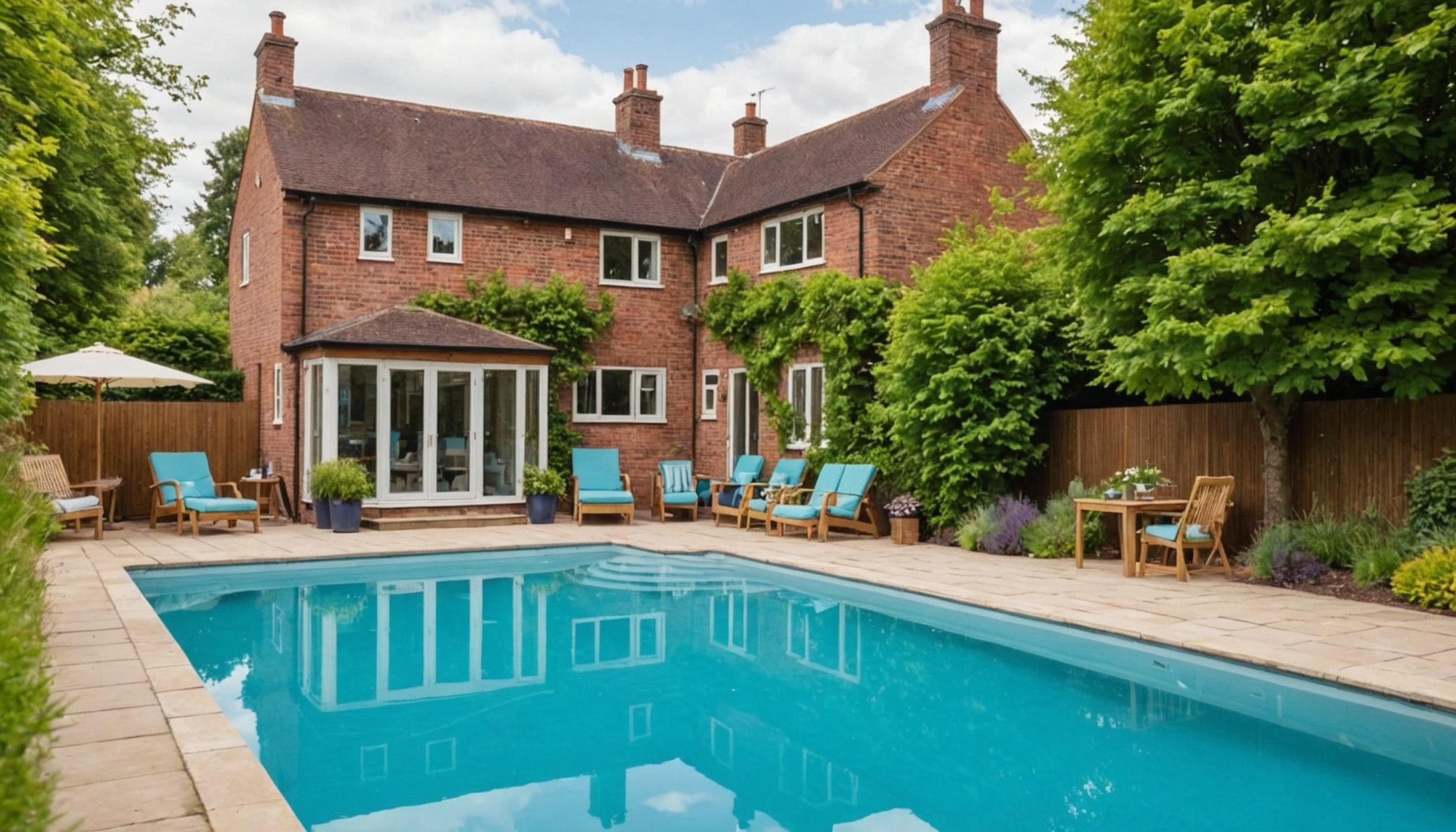Design Inspiration for a Family-Friendly Pool Area
Designing a family-friendly pool area requires thoughtful integration of features that cater to both adults and children. Incorporating vibrant colours and themes can create an inviting atmosphere for young ones. Think bright accessories, playful murals, or thematic decals around the pool’s edge.
Another key aspect is the inclusion of children’s pool features such as shallow areas or splash zones specifically designed for younger kids. These features ensure safety and allow for age-appropriate fun. Splash pads with interactive elements can add excitement without the depth concerns of larger pools.
A voir aussi : Creative Strategies for Designing a Tiered Pool Deck in Your Sloped UK Backyard
Moreover, when considering pool area design, creative landscaping plays a significant role. It can transform the pool area into a magical playground. Using soft grass, safe pathways, and whimsical plant arrangements can make the environment more enticing and user-friendly. Adding shaded spots not only offers respite from the sun but invites families to linger longer, enjoying the outdoors.
In summary, the goal is to blend appealing aesthetics with practical considerations, creating a pool area that is both enjoyable and family-friendly. Thoughtful planning ensures a harmonious balance between adult leisure and children’s playful exploration. With careful design choices, families can enjoy a pool area that truly meets the needs of every member.
A lire en complément : Creating the Ultimate Dual-Purpose Pool for Relaxation and Fitness in Your UK Home
Essential Safety Measures
Ensuring pool safety is paramount, particularly where children are involved. Strong safety fencing acts as the first line of defence. Installing barriers that are at least four feet high with childproof gates can prevent unsupervised access. It’s crucial to check these features for wear and tear regularly to maintain their effectiveness.
Non-slip surfaces surrounding the pool area help reduce the risk of falls. Opting for materials specially designed for wet conditions, such as textured concrete or rubber mats, can safeguard against common poolside accidents.
Establishing clear pool rules is another pivotal step in enhancing child safety. It’s vital that children comprehend what is expected of them when near water, including no running, diving only in designated areas, and no swimming without adult supervision. Rules should be consistently enforced by all adults present, reinforcing the importance of safety.
Alongside rules, maintaining adult supervision is non-negotiable. Assign a designated adult when children are present at the pool to ensure constant supervision. This approach significantly lowers the risk of accidental drowning, as it ensures immediate intervention if a problem arises.
By implementing these safety measures, the pool can be a safer environment, helping to alleviate parents’ concerns and allowing everyone to enjoy the water more confidently.
Innovative Features to Engage Kids
Exploring ways to make pool time exciting can involve a variety of pool fun features. Integrating water play elements easily keeps kids amused. Think about adding splash pads or fountains. These offer gentle sprays that are perfect for countless hours of enjoyment and laughter. Transforming static pools into dynamic playgrounds can be simple and thrilling.
Water Play Elements
Moving water gear, like small slides, not only adds excitement but also provides a safe thrill for children. When choosing slides, ensure they fit well with the pool’s size and depth. Always consider the safety and age appropriateness of these features.
Interactive Pool Toys
Another popular option is including kid-friendly accessories and pool toys. Opt for floatables with engaging designs or toys that encourage interactive play. Diving rings, water guns with adjustable pressure settings, and foam noodles are loved by kids. They should be crafted from durable materials to withstand continuous splashing and sun exposure.
Slide and Diving Board Options
For older children, selecting robust vertical features like diving boards is essential. These should be installed with correct measurements and safety standards in mind. Choose boards with non-slip surfaces and adjustable heights to cater to varied skill levels. By creating an inviting and safe space, kids are inspired to unleash their imagination and enjoy countless hours of poolside adventure.
Maintenance Tips for a Safe Swimming Experience
Proper pool maintenance is essential for ensuring both safety and health, especially in the unique climate of the UK. Implementing regular maintenance routines can significantly improve your swimming experience. Key practices involve ensuring the water quality remains optimal through consistent testing and balancing of chemical levels.
Performing routine safety checks should never be underestimated. Regular inspections of safety equipment, such as life rings and pool covers, are crucial. Ensure that all safety barriers and alarms are functioning correctly to prevent accidents. This measure is especially important if small children are present around the pool area.
Seasonal maintenance is also vital. As the climate in the UK shifts, so must your pool maintenance habits. In the spring, focus on removing debris that may have accumulated during winter. Check for any damages to the pool structure caused by freezing temperatures. Summer requires more frequent water testing due to increased usage. Heading into autumn, maintaining leaf nets can prevent clogging of the pool’s filtration system.
By following these clean pool practices, you not only enhance the lifespan of your pool but create a safe environment for all users. Consistent maintenance ensures that the pool remains a place of fun and relaxation.
Regulatory Compliance and Best Practices
Navigating UK pool regulations is crucial for any pool owner or builder. To ensure safety and legality, adhere to current legal standards set by local councils and relevant authorities. These regulations often encompass water quality, fencing, and safety equipment requirements.
Securing the right certifications is just as important. Recommended certifications for pool builders include Constructionline, which verifies technical proficiency, and CHAS, which denotes compliance with health and safety regulations. Similarly, safety inspectors should be aligned with the Royal Life Saving Society UK or equivalent certifications to reassure compliance and expertise.
Adhering to sensible practices is essential for maintaining a compliant and safe pool environment. Start with these compliance tips:
- Invest in a professional inspection before opening your pool.
- Implement suitable safety barriers such as self-closing gates and pool covers.
- Regularly test water quality to meet health safety standards.
- Display safety signage that warns of potential hazards.
Incorporating these tips can significantly reduce risks associated with residential pools. Pool owners should regularly update themselves on legal standards and utilize these compliance tips, ensuring their pool area remains safe and enjoyable for all users. By integrating comprehensive UK pool regulations knowledge into your pool management, safety is significantly enhanced.











